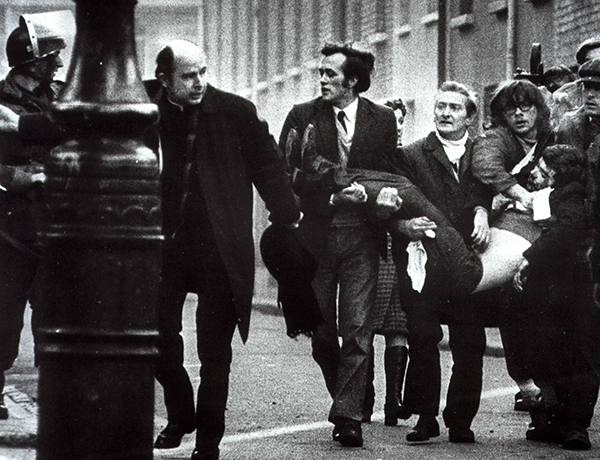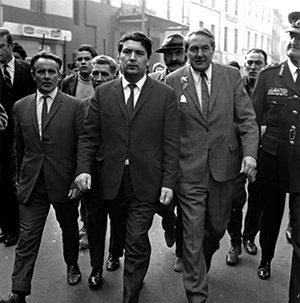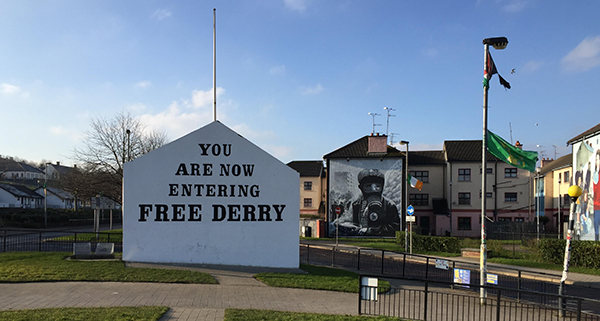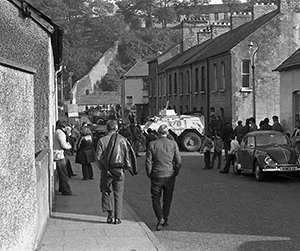Post-Bloody Sunday community politics in Derry’s Bogside
Published in Features, Issue 1 (January/February 2020), Volume 28Did Bloody Sunday really create ‘a nation in revolt’ that eschewed constitutional politics?
By Dan Haverty
A close examination of community politics in Derry’s Bogside after ‘Bloody Sunday’ reveals a robust network of citizens’ associations dedicated to non-violent reform. Even after Bloody Sunday (30 January 1972), most Catholic residents continued to support the moderate proposals originally advocated by the civil rights movement. One of the fundamental causes of the conflict in Derry in 1968–9 was that the Catholic community had virtually no access to the levers of power. Much of this was due to the city’s gerrymandered electoral districts and the consequent monopoly over municipal politics held by the ruling Ulster Unionist Party. Compounding this problem was a lack of effective leadership in the Nationalist Party, the only major party that represented the Catholic community’s interests. These underlying conditions ensured that when activists began to seek social change in the early 1960s they did so outside the normal mechanisms of state and their organisations were composed almost entirely of Catholics. The earliest of these organisations were locally based tenants’ associations that agitated against local landlords for more secure tenancies and improved living conditions.

Above: Bloody Sunday, 30 January 1972—Fr Edward Daly leads a group carrying the fatally wounded Jackie Duddy. (Stanley Matchett, Belfast Telegraph)
Bogside Citizens’ Association
Tenants’ associations proved popular among local residents and were present in all Derry working-class communities by 1967. Indeed, when inter-community relations deteriorated in the late 1960s, they provided the foundation for the earliest meaningful efforts towards local self-governance. The onset of paramilitary violence, the suspension of the Stormont parliament, the deployment of the British Army and the abolition of the B-Specials all combined to create the perception of State collapse. Residents in the overwhelmingly Catholic Bogside reacted to these changes by organising into a more formal community association. In April 1972—just three months after Bloody Sunday—residents formed the Bogside Citizens’ Association (BCA), a locally governed organisation which, according to its founding constitution, aimed to ‘[improve] the physical environment of the area … [utilise and add] to the existing recreational facilities and thus [provide] a better social life … [and set] up a body of citizens who will discourage anti-social behaviour’. The creation of a similar Creggan Community Association followed shortly after. These citizens’ associations claimed that their aims were not political; nevertheless, while they do appear not to have had political inclinations, the timing of their formation and the void that they filled meant that they were, in effect, embryonic political institutions subconsciously formed to replace the collapsing municipal authorities.
The BCA was widely popular among Bogside residents. The Derry Journal reported that approximately 4,500 of 6,000 eligible ‘voters’ cast their ballots for the first BCA executive, a turnout of 74.7%—healthy by almost all democratic standards. The election was endorsed by leading activist and politician John Hume, giving the institution respectability and legitimacy. The BCA was notably critical of the local IRA and often worked to limit its activities. Indeed, it successfully brokered a temporary truce between the IRA and the British Army in April 1974 to allow for a community festival, and it very nearly negotiated the removal of the ‘Free Derry’ barricades on the eve of the British Army’s July 1972 operation into the no-go areas. These episodes demonstrate that the overwhelming majority of local residents were eager to participate in a form of self-government and also that they remained committed to non-violent action even after Bloody Sunday.

Above: John Hume on walkabout in the Bogside with Home Secretary James Callaghan in August 1969. In April 1972 he endorsed the election of the Bogside Citizens’ Association (BCA), giving the institution respectability and legitimacy. (Larry Doherty)
‘Community watch’ proposal
The community’s opposition to total independence was perhaps best demonstrated in May 1975, when the BCA proposed the formation of a ‘community watch’ that would fall completely under the auspices of its executive and would ‘provide police facilities to the BCA area’. The proposal was harshly criticised by Derry unionists, who accused it of blatant sectarianism. Nationalists were split. Republicans remained mostly ambivalent—likely owing to the promise it held of promoting greater autonomy—but the SDLP, while acknowledging the creative efforts of the local community, opposed the proposal, arguing that policing was best resolved by reforming the city-wide RUC in a way that was acceptable to the entire community. The establishment of a de facto Catholic police force would have been a decisive step towards local autonomy, and thus the community’s collective response to the proposal provides a useful barometer of mid-1970s nationalist sentiment.
When the proposal was put to a vote, only a fraction of the Bogside community actually supported it. Less than half of the eligible voters participated in the referendum, of whom about two thirds voted in favour—a final tally of only one third. Although the BCA executive unconvincingly claimed that the result showed a ‘massive rejection of the RUC’, it ultimately chose to abandon the plan. The outcome of the ‘community watch’ referendum is instructive because it demonstrated the ‘red line’ beyond which residents were no longer willing to support self-governance. They had happily supported the formation of tenants’ rights groups and overwhelmingly participated in the creation of quasi-self-governing citizens’ associations, but when the BCA was prepared to assume the use of force—considered the single defining characteristic of statehood by most political scientists—they were no longer on board. This does not suggest that Catholic nationalists were now apathetic to reform; the persistence of citizens’ associations beyond 1975 demonstrates that residents still demanded sweeping fundamental change. Indeed, they probably mostly supported the view of John Hume and the local SDLP that a reformed police force that served the entire city was the most effective way forward. While these developments occurred independently of the IRA, they do suggest not only that non-violent community-based organisations commanded wide respect in Catholic communities but also that moves towards independence, which would have at least reinforced republicanism, were unpopular and actively opposed.
Challenging the republican narrative
The republican conception of the origins of the conflict rests partly on overly simplistic claims made during the early 1970s. A contemporary piece of local evidence provides an illuminating example of the mechanisms used by republicans to capture local grievances and reframe them to fit their political aims. In June 1972 the IRA drafted a set of peace proposals and asked Derry Catholics to indicate their support through referendum. Their demands were (1) an end to internment, (2) amnesty for all ‘political prisoners’ and (3) withdrawal to barracks of British troops ‘pending their withdrawal from the country’. According to contemporary republican sources, 9,000 out of 15,000 of those eligible cast votes, a modestly healthy 60% turnout. Of these, a staggering 7,750 voted in favour, while only 1,015 voted against. Barney McFadden, a prominent local republican, praised the outcome, claiming that ‘this referendum demonstrates to the world that the people of Derry … desire to be a free people and a free nation’. Although historians should be cautious of relying too heavily on initiatives with no official oversight and which were designed to reinforce a predetermined outcome, even a critical analysis of the evidence at hand does not support the republican concept of a ‘nation in revolt’.

Above: Free Derry Corner today. In July 1972 the BCA very nearly negotiated the removal of the ‘Free Derry’ barricades on the eve of the British Army’s Operation Motorman into the no-go areas.
The SDLP rejected the IRA’s peace demands outright and urged its supporters to boycott the referendum. Similarly, the Creggan Community Association advised its supporters not to participate in the ‘ambiguously worded questionnaire’. While it is impossible to determine what percentage of the approximately 6,000 voters consciously engaged in the boycott, the SDLP’s eminent political presence, coupled with the widespread popularity of the citizens’ associations, suggests that a substantial portion of those voters were opposed to IRA-dictated peace terms. Indeed, even if one examines only the result itself, the referendum’s design contained structural biases that made the result wholly insufficient to support Sinn Féin’s claim that Derry Catholics sought to be ‘a free people and a free nation’. Republicans did not offer voters the option to select which terms they supported and which they opposed, and therefore a vote for one was effectively a vote for all.

Above: An internment sweep in the Bogside, August 1971, in which dozens of local residents were arrested and detained. But did local opposition to internment necessarily equate to support for the Provisional IRA’s armed campaign? (Museum of Free Derry)
The three terms of substance—end of internment, release of prisoners and withdrawal of British troops—reflected widespread local grievances, and, taken separately, they were not necessarily political. Internment in particular was deeply unpopular. Dozens of local residents were arrested and detained during internment sweeps in 1971, which not only removed them indefinitely from the community but also caused considerable distress among their families, who were not usually provided with information as to their whereabouts. Furthermore, the presence of British soldiers was extraordinarily disruptive. Roadblocks became a fixture of daily life, often prolonging work commutes and restricting movement throughout the city. Residents were also frequently subjected to random searches, which were not only highly intrusive but also publicly humiliating. Perhaps most importantly, soldiers were often implicated in the shootings of local people. In addition to Bloody Sunday, these events demonstrated the danger they posed to public safety. Within this context, it is easy to understand why reactive individuals would have supported the IRA, but one can also understand why distraught and concerned families would have supported the end of internment and the removal of armed soldiers and still remain indifferent to republican political objectives.
On their own, then, the terms outlined in the IRA’s peace proposals neither presuppose Irish unification nor indicate public support for the armed campaign. Those who designed the referendum understood this, and the inclusion of the addendum ‘pending [the British Army’s] withdrawal from the country’ was meant to provide Sinn Féin with the crutch on which to project the referendum result as a public demand for a complete British withdrawal from Ireland. Although it was still phrased rather vaguely, the statement does suggest unification as an objective because republicans believed that Northern Ireland was sustained only by force and that the removal of the military would necessarily lead to political unification.
Conclusion
The nuances of Bogside community politics after 1972 suggest that the shift in the Catholic community’s support from constitutional nationalism to militant republicanism has been exaggerated. The Provisional IRA undoubtedly experienced a surge in support within these communities after Bloody Sunday that allowed it to insert itself as a dominant player in local politics. The presence of a widely popular network of citizens’ associations, however, indicates that the overwhelming majority of Bogside residents continued to support non-violent and relatively moderate solutions to the issues facing their community. In fact, while the use of State violence on Bloody Sunday did certainly provide the IRA with the outlet it needed to intensify its armed campaign, there does not seem to have been any broad shift in public opinion away from non-violent social reform towards independence. Indeed, the fact that citizens’ associations were formed only after Bloody Sunday might be an indication that the use of State violence actually strengthened the resolve of residents seeking to establish a system of greater local self-governance. The fact that the centre of the conflict shifted demonstrably away from Derry and towards Belfast after 1972 might reinforce these findings, because it suggests that both the IRA and the British Army chose to refocus their efforts on Belfast, where support for militant republicanism was stronger than in Derry. Further studies of similar developments in Belfast, Newry, Strabane and other northern cities with substantial nationalist communities will broaden the issues discussed in this article, which will deepen our understanding of the events surrounding the beginning of the conflict.
Dan Haverty is currently an editorial fellow at Foreign Policy in Washington DC.
FURTHER READING
A. Kerr, Free Derry: protest and resistance (Derry, 2013).
N. Ó Dochartaigh, From Civil Rights to Armalites: Derry and the birth of the Irish Troubles (Dublin, 1977).
S. Prince & G. Warner, Belfast and Derry in revolt: a new history of the start of the Troubles (Dublin, 2012).
B. Purdie, Politics in the streets: the origins of the civil rights movement in Northern Ireland (Belfast, 1990).
















